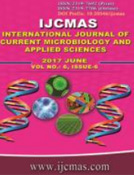


 National Academy of Agricultural Sciences (NAAS)
National Academy of Agricultural Sciences (NAAS)

|
PRINT ISSN : 2319-7692
Online ISSN : 2319-7706 Issues : 12 per year Publisher : Excellent Publishers Email : editorijcmas@gmail.com / submit@ijcmas.com Editor-in-chief: Dr.M.Prakash Index Copernicus ICV 2018: 95.39 NAAS RATING 2020: 5.38 |
Bacterial wilt caused by Ralstonia solanacearum is the most destructive disease of crop plants. Six isolates of R. solanacearum causing wilt disease in tomato (Solanum lycopersicum) and brinjal (S. melongena) were collected from different locations of Karnataka, India. All the six isolates were identified as R. solanacearum by colonies phenotype, simple staining, streaming and R. solanacearum species specific PCR. In this study, six isolates were differentiated into race on the basis of their ability to infect different host. The isolates-1, 2, 4 and 5 were established as race-3 and isolates-3 and 6 were established as race-1. Biovar characterization was performed by their ability to utilize disaccharides [Sucrose, lactose, and maltose (Himedia)] and sugar alcohols [mannitol, sorbitol and dulcitol (Himedia)]. According to Hayward`s classification system, the isolates-1, 2, 4 and 5 were belongs to biovars-2 and isolates-3 and 6 were belongs to biovars-3. Molecular analysis, including multiplex PCR-based phylotyping and sequence analysis of 16s rDNA were used to determine the ITS sequences of six R. solanacearum strains. The results of Pmx-PCR for all six isolates revealed that all isolates are belonged to phylotype I. Therefore, it may be confirmed that R. solanacearum causing bacterial wilt of tomato and brinjal in Karnataka belong to Biovar-2, 3 and Race 1, 3 and phylotype I.
 |
 |
 |
 |
 |